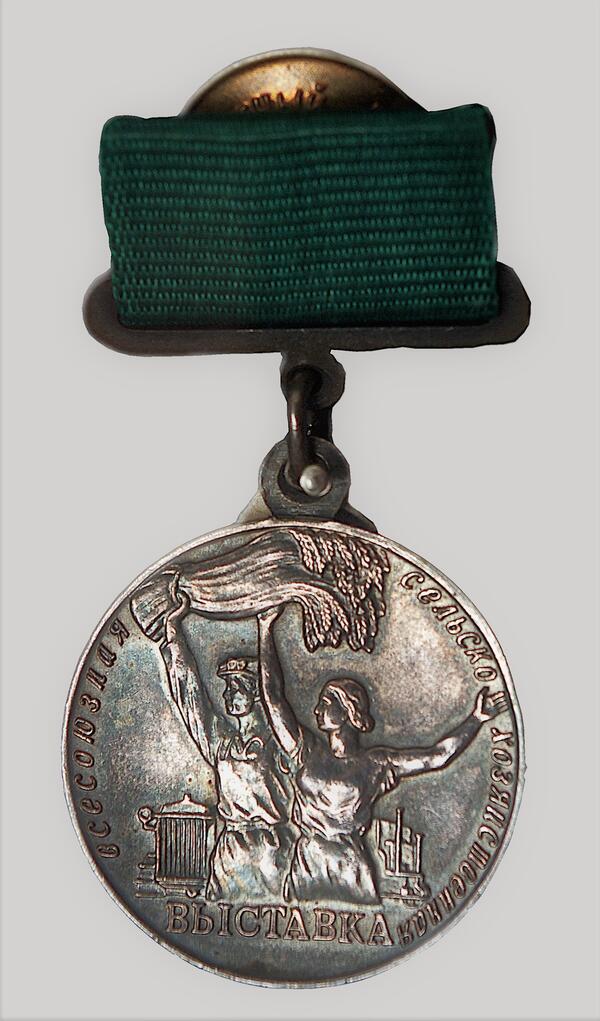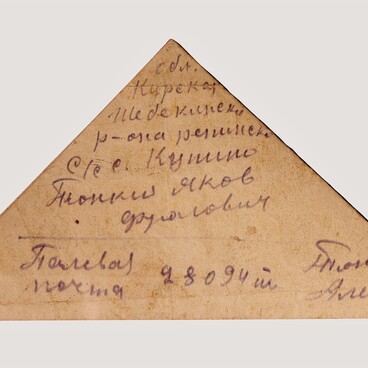The Shebekino History and Art Museum houses a minor medal of the All-Union Agricultural Exhibition (AUAE). It belonged to Alexander Kapralsky, who in 1940 was the editor of the Shebekino district newspaper “Plamya” [“Flame”] and a regular participant of the exhibition.
In the postwar years Kapralsky worked as the second secretary of the district committee of the All-Union Communist Party (bolsheviks) of Solntsevo district, the Kursk region. Since 1957 he headed the collective farm “Russia”. He was more than once a participant of the All-Union Agricultural Exhibition and the All-Union Exhibition of Economic Achievements. At one of these exhibitions he was awarded a minor silver medal.
Minor medal was made of 925 silver and weighed 12 grams. The front side shows a worker and a collective farmer raising a sheaf of wheat. On the reverse side, at the edges, there are ears of wheat, and in the center, there is a “Stalinets” agrimator. At the top you can see the inscription: “For successes in socialist agriculture”.
The medal had two attachment options: on the back, on the bar, there was either a pin or a screw that was threaded through, for example, a button loop and screwed on with a nut. The ribbons also varied in color: green was the most common, but pink, red, blue and yellow were also found.
Medals were awarded by the Main Committee of the All-Union Agricultural Exhibition. They were awarded to the participants who showed the best work and broke agricultural records. In addition to silver medals, there were also gold medals.
The first All-Union Agricultural exhibition was opened on August 1, 1939. The preparations took several years: 52 exhibition pavilions were built on a wasteland in the north-east of Moscow, each corresponding to the national style of the Union Republic. In addition, 200 service buildings were erected on the territory, and a year before its opening, in 1938, the sculpture “Worker and Collective Farm Girl” by Vera Mukhina was brought to Moscow from Paris.
During the first three months of the All-Union Agricultural Exhibition, it was visited by 3.5 million people. In addition to residents of Moscow, who vacationed there on weekends, the pavilions brought tourists — for excursions.
During the war, the exhibition was closed and resumed only in 1948. It took six years to reconstruct the buildings and territory: the destroyed pavilions were replaced with new ones, and the fountains “Friendship of Peoples”, “Stone Flower” and “Golden Spike” were built. In 1956 the exhibition was divided into two areas: agricultural and industrial. In 1958 they were united again in the Exhibition of National Economic Achievements of the USSR — VDNKh.
In the postwar years Kapralsky worked as the second secretary of the district committee of the All-Union Communist Party (bolsheviks) of Solntsevo district, the Kursk region. Since 1957 he headed the collective farm “Russia”. He was more than once a participant of the All-Union Agricultural Exhibition and the All-Union Exhibition of Economic Achievements. At one of these exhibitions he was awarded a minor silver medal.
Minor medal was made of 925 silver and weighed 12 grams. The front side shows a worker and a collective farmer raising a sheaf of wheat. On the reverse side, at the edges, there are ears of wheat, and in the center, there is a “Stalinets” agrimator. At the top you can see the inscription: “For successes in socialist agriculture”.
The medal had two attachment options: on the back, on the bar, there was either a pin or a screw that was threaded through, for example, a button loop and screwed on with a nut. The ribbons also varied in color: green was the most common, but pink, red, blue and yellow were also found.
Medals were awarded by the Main Committee of the All-Union Agricultural Exhibition. They were awarded to the participants who showed the best work and broke agricultural records. In addition to silver medals, there were also gold medals.
The first All-Union Agricultural exhibition was opened on August 1, 1939. The preparations took several years: 52 exhibition pavilions were built on a wasteland in the north-east of Moscow, each corresponding to the national style of the Union Republic. In addition, 200 service buildings were erected on the territory, and a year before its opening, in 1938, the sculpture “Worker and Collective Farm Girl” by Vera Mukhina was brought to Moscow from Paris.
During the first three months of the All-Union Agricultural Exhibition, it was visited by 3.5 million people. In addition to residents of Moscow, who vacationed there on weekends, the pavilions brought tourists — for excursions.
During the war, the exhibition was closed and resumed only in 1948. It took six years to reconstruct the buildings and territory: the destroyed pavilions were replaced with new ones, and the fountains “Friendship of Peoples”, “Stone Flower” and “Golden Spike” were built. In 1956 the exhibition was divided into two areas: agricultural and industrial. In 1958 they were united again in the Exhibition of National Economic Achievements of the USSR — VDNKh.



